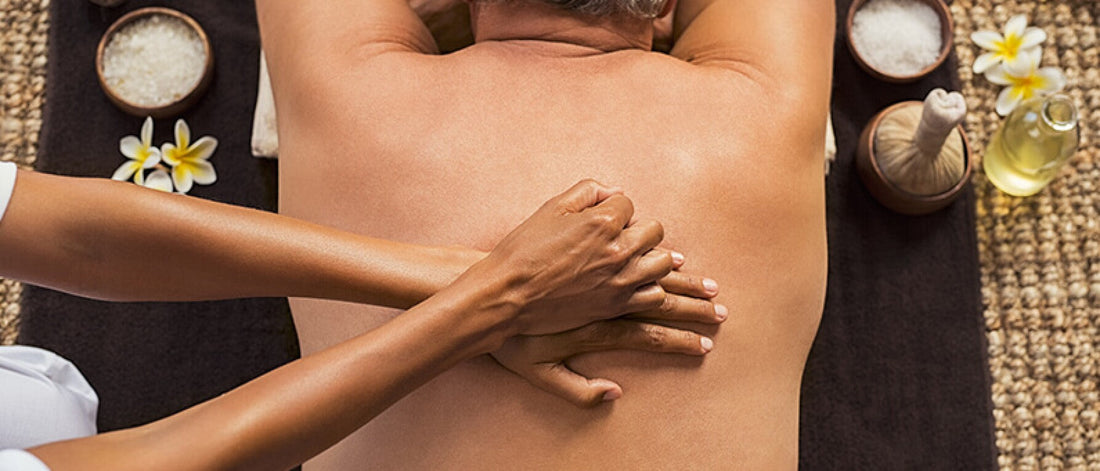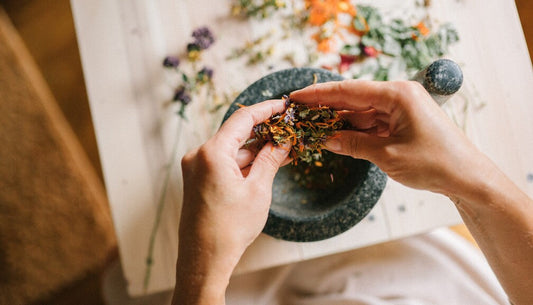Ayurveda is an elegant system of healing, first described around 5,000 years ago in ancient Vedic texts as comprehensive teachings on preserving and maintaining health. The fact that this ancient medicine is still in use today is a testament to the wisdom it holds when it comes to understanding the human potential to achieve a happy and wholesome life.
Primordial in essence, Ayurveda serves to awaken your body’s ability to restore balance using principles that are seemingly basic and yet profound. These same principles are mirrored in many indigenous cultures today, especially when it comes to the importance of restoring harmony or balance to cultivate good health. In addition, woven into Ayurvedic teachings is a sense of love and compassion for each person’s healing journey and a reminder to regard yourself in the same way.
One of the first things you will learn about or experience when starting to delve into the world of Ayurveda is the cleansing and rejuvenation process called panchakarma, where you quite literally clean the slate and start anew.
What Is Panchakarma?
Panchakarma eliminates accumulated impurities from the mind-body physiology; it is essentially a detoxification program. Pancha in Sanskrit means “five,” and karma means “action” and refers to five different purifying and rejuvenating procedures in Ayurveda. When it was initially designed thousands of years ago, there weren’t as many causes for unhealthy accumulations in the body, but it was still necessary to create this sophisticated panchakarma detox program. Today, as improper diet, stress, and environmental hazards abound, panchakarma can be of great help.
A panchakarma program takes place over the course of several days, allowing plenty of time and space to rest and process the experience. Each step in the program is purposeful and is meant to ultimately restore your body’s innate healing ability. Your body knows how to cleanse itself quite efficiently and is well-equipped to remove waste through various channels such as:
Panchakarma helps to gently clear the channels of removal in the body so that everything runs smoothly and efficiently, like a well-oiled machine. In the process, your mental and emotional bodies go through their own cleansing process as well. The mind and body are intricately connected according to Ayurveda. What you do to one affects the other. For example, when you feel stress you will always feel it somewhere in your body. Or, when you have a good workout, your mind feels light and clear.
It’s important to understand a few fundamental concepts of Ayurveda to help fully appreciate what makes panchakarma effective even at the most subtle levels.
Here is the Ayurvedic definition of good health in Sanskrit, followed by the general translation:
Sama dosha, sama agnischa
Sama dhatu mala kriyah
Prasanna atma indriya manahwww
Swastha iti abhidhiyate
One whose doshas are balanced, whose digestive fire is balanced,
whose bodily tissues and elimination processes are functioning normally,
and whose senses, mind, and self are filled with bliss;
such a one is called a healthy person.
Ayurveda teaches that your natural state is one of health, happiness, and an inner sense of well-being. As the above definition confirms, this can be achieved when your body is clear of toxins, your mind is at peace, your emotions are calm and happy, your wastes are efficiently eliminated, and your organs are functioning normally. This sounds great, but how do you not only get to this point but also maintain it? This is where Ayurveda shines.
When agni is weak, it leads to improper digestion of food, experiences, and emotions and results in an accumulation of undesired impurities usually referred to as toxins. Ayurveda refers to these incompletely metabolized materials as ama and is viewed as toxic residue. The presence of ama clogs the channels in the body that are in charge of waste removal and circulation. Thus, proper assimilation and nourishment are denied to the mind-body physiology.
Ama is described as:
In the world is busy, stressful, and toxic that places a huge strain on your physical and mental systems, especially over time. While you may not see it with your eyes, you most assuredly feel it. Stress is a huge problem and is the cause of many ailments. How can you focus on creating a happy life that Ayurveda promotes when you feel like crap? The first step is clearing out the gunk, or ama, through panchakarma and then learning tools to maintain good health.
There are three main components of the panchakarma process:
You are instructed to take increasing quantities of herbalized oils by mouth, which are designed to lubricate your digestive system. The Chopra Center’s recipe for Bliss Balls include ingredients that are meant to stoke agni as well as provide lubrication. In addition, the preparation phase may also include ginger tea as well as herbal supplements such as triphala and guggulu.
During the principal procedures phase, now that your body has been prepped, your focus is on the elimination of toxins. This is where the five classical therapies would take place. Instead, alternative treatments are given that provide similar benefits and include the following:
Your body and mind thrive when given moments of respite and some peace. Panchakarma not only rejuvenates your body and mind but also teaches you about yourself. The value of knowing what good health feels like, even if it’s just a glimpse, provides a sense of hope that it’s possible to live in this world and feel good. Give panchakarma a try!
*Editor’s Note: The information in this article is intended for your educational use only; does not necessarily reflect the opinions of the Chopra Center's Mind-Body Medical Group; and is not a substitute for professional medical advice, diagnosis, or treatment. Always seek the advice of your physician or other qualified health providers with any questions you may have regarding a medical condition and before undertaking any diet, supplement, fitness, or other health program.
Primordial in essence, Ayurveda serves to awaken your body’s ability to restore balance using principles that are seemingly basic and yet profound. These same principles are mirrored in many indigenous cultures today, especially when it comes to the importance of restoring harmony or balance to cultivate good health. In addition, woven into Ayurvedic teachings is a sense of love and compassion for each person’s healing journey and a reminder to regard yourself in the same way.
One of the first things you will learn about or experience when starting to delve into the world of Ayurveda is the cleansing and rejuvenation process called panchakarma, where you quite literally clean the slate and start anew.
What Is Panchakarma?
Panchakarma eliminates accumulated impurities from the mind-body physiology; it is essentially a detoxification program. Pancha in Sanskrit means “five,” and karma means “action” and refers to five different purifying and rejuvenating procedures in Ayurveda. When it was initially designed thousands of years ago, there weren’t as many causes for unhealthy accumulations in the body, but it was still necessary to create this sophisticated panchakarma detox program. Today, as improper diet, stress, and environmental hazards abound, panchakarma can be of great help.
A panchakarma program takes place over the course of several days, allowing plenty of time and space to rest and process the experience. Each step in the program is purposeful and is meant to ultimately restore your body’s innate healing ability. Your body knows how to cleanse itself quite efficiently and is well-equipped to remove waste through various channels such as:
- Sweat glands
- Blood vessels
- Urinary tract
- Intestines
Panchakarma helps to gently clear the channels of removal in the body so that everything runs smoothly and efficiently, like a well-oiled machine. In the process, your mental and emotional bodies go through their own cleansing process as well. The mind and body are intricately connected according to Ayurveda. What you do to one affects the other. For example, when you feel stress you will always feel it somewhere in your body. Or, when you have a good workout, your mind feels light and clear.
Classic and Modern Panchakarma
As with anything that has been around for a very long time, panchakarma has evolved throughout the years and the modes of practice have differed throughout India. For a little history, here are the five classical elements that make up panchakarma therapy as they were originally written:- Basti: Herbalized oil enemas
- Nasya: Nasal irrigation
- Vamana: Therapeutic vomiting
- Virechana: Purgation
- Raktamokshana: Bloodletting
- Herbal oil massages
- Steam baths
- Cleansing enemas
- Nasal administration
- Gentle laxatives (senna)
- Specialized diet
It’s important to understand a few fundamental concepts of Ayurveda to help fully appreciate what makes panchakarma effective even at the most subtle levels.
Ayurvedic Definition of Good Health
What is the definition of good health? Ask on an individual basis and you’ll find many definitions based on such things as life experiences, culture, and health history. With any good journey, it’s helpful to know where you are going—what the goal is. Then, steps can be taken to seek out ayurvedic healing accordingly.Here is the Ayurvedic definition of good health in Sanskrit, followed by the general translation:
Sama dosha, sama agnischa
Sama dhatu mala kriyah
Prasanna atma indriya manahwww
Swastha iti abhidhiyate
One whose doshas are balanced, whose digestive fire is balanced,
whose bodily tissues and elimination processes are functioning normally,
and whose senses, mind, and self are filled with bliss;
such a one is called a healthy person.
Ayurveda teaches that your natural state is one of health, happiness, and an inner sense of well-being. As the above definition confirms, this can be achieved when your body is clear of toxins, your mind is at peace, your emotions are calm and happy, your wastes are efficiently eliminated, and your organs are functioning normally. This sounds great, but how do you not only get to this point but also maintain it? This is where Ayurveda shines.
The Importance of Detoxification
According to Ayurveda, good health depends on your body and mind’s ability to metabolize all of life’s experiences, both good and bad. This is why digestion, or agni, is important as it relates to the metabolization of life on all levels. Agni means gastric fire, enzymes, and metabolism and determines how efficiently you are able to convert information in the form of food, emotions, and experiences into nourishment. When agni, and the gastrointestinal tract (or GI tract for short), is strong, everything is broken down and absorbed into your mind-body physiology as appropriate. Anything that is not useful is eliminated from your body and mind. Start to notice how you personally metabolize the world around you and how it affects you.When agni is weak, it leads to improper digestion of food, experiences, and emotions and results in an accumulation of undesired impurities usually referred to as toxins. Ayurveda refers to these incompletely metabolized materials as ama and is viewed as toxic residue. The presence of ama clogs the channels in the body that are in charge of waste removal and circulation. Thus, proper assimilation and nourishment are denied to the mind-body physiology.
Ama is described as:
- Heavy
- Thick
- Cold
- Foul
- Light
- Clear
- Hot
- Pure
In the world is busy, stressful, and toxic that places a huge strain on your physical and mental systems, especially over time. While you may not see it with your eyes, you most assuredly feel it. Stress is a huge problem and is the cause of many ailments. How can you focus on creating a happy life that Ayurveda promotes when you feel like crap? The first step is clearing out the gunk, or ama, through panchakarma and then learning tools to maintain good health.
Signs You Might Benefit from Panchakarma
The signs of ama accumulation can be obvious. If you notice you have any of the following symptoms, you might benefit from a panchakarma program:- Thick layer of coating on the tongue
- Tired throughout the day, especially after meals
- Body aches and pains
- Uncontrollable cravings
- Foggy mind
- Bad smelling breath, odor, and flatulence
- Constipation or diarrhea
The Panchakarma Treatment
Are you convinced you need panchakarma? Here is what to expect. Depending on the facility, your panchakarma program may slightly vary. It’s always under the supervision of a medical doctor and/or an Ayurvedic physician. The program is specialized and is tailored to your mind-body constitution or dosha(s). It is often recommended to stay in-house for treatment in order to get the most out of the experience. The following description of a panchakarma program is based on the Chopra Center’s 10-day Perfect Health Retreat.There are three main components of the panchakarma process:
- Preparation phase (poorva karma)
- Principal procedures (pradhana karma)
- Post-therapy procedures (paschat karma)
You are instructed to take increasing quantities of herbalized oils by mouth, which are designed to lubricate your digestive system. The Chopra Center’s recipe for Bliss Balls include ingredients that are meant to stoke agni as well as provide lubrication. In addition, the preparation phase may also include ginger tea as well as herbal supplements such as triphala and guggulu.
During the principal procedures phase, now that your body has been prepped, your focus is on the elimination of toxins. This is where the five classical therapies would take place. Instead, alternative treatments are given that provide similar benefits and include the following:
- Bastis, or herbalized enemas, are administered. They are made up of herbalized oils that flush out your intestinal tract, accessing the deeper tissues and eliminating fat-soluble toxins. While it may not sound appealing, the whole process is meant to be gentle. Senna can be used as part of this phase as an additional gentle laxative.
- Nasya, or nasal applications, are medicinal oils that are applied throughout the nasal passages, clearing the sinuses and draining excess mucus. If you suffer from chronic sinus problems or allergies, you may find relief. This step can feel soothing and calms your mind.
- Swedana, or sweat treatments, are next. Dry and wet saunas open up your pores and begin to rid the body of impurities through your sweat glands. It helps to dilate circulation and speeds up the elimination of impurities that have been loosened by oleation. It also encourages a general state of relaxation.
- Abhyanga, or oil massage, is the external oleation of the body. The type of oil along with the herbs used to prepare the oil are based on the recommendations of the overseeing doctor. In panchakarma, massage serves as a way to provide oil to the tissues, loosen impurities, and encourage those impurities to start making their way out through your channels of elimination. Each day is a different massage treatment and is scheduled in a specific order that is optimal for cleansing.
- Yoga
- Meditation
- Dosha-specific diet
- Daily abhyanga
- Pranayama
Example of a typical day:
- Wake up with sunrise and practice gentle yoga and meditation.
- Drink a cup of spiced tea with cumin, ginger, cardamom, fennel seeds, and other spices and herbs for your dosha.
- Enjoy a light breakfast.
- Begin your first treatment of the day, such as an oil massage.
- Spend time in the dry or wet steam room to release toxins.
- Eat a detoxifying lunch of kitchari, lentils, and rice in healing spices.
- Walk around in nature or sit and meditate. Try to detach from technology!
- Take naps as needed.
- Undergo another treatment, such as the herbalized basti.
- Consume a light dinner of more kitchari or cooked vegetables and rice.
- Read, meditate, or journal and then head to bed.
Why Should You Try Panchakarma Treatments?
You don’t have to be sick to benefit from panchakarma. If you are healthy, then you will become stronger and have more energy. If you are sick, it will gently encourage you back to health in a natural way. Prevention is important! Anything you can do to maintain a state of balance will help in the long run and ensure a long wholesome life. Here are a few of the benefits of doing panchakarma:- Eliminates impurities from your body and mind
- Restores your mind-body constitutional balance (or doshas), improving health and wellness
- Strengthens your immune system and you become more resistant to illness
- Reverses the negative effects of stress on your body and mind thereby slowing the aging process
- Enhances your self-reliance, strength, energy, vitality, and mental clarity
- Brings about deep relaxation and a sense of health and well-being
How Often and When
Traditionally, Ayurveda suggests doing panchakarma with the change of the seasons, so about three times per year. Any time you experience transitions, things can get out of balance and accumulations occur. Anytime you feel out of sorts or ill, consider panchakarma. The whole process helps to remind you about the importance of taking care of yourself and honoring where you are at and what you need in the moment.Your body and mind thrive when given moments of respite and some peace. Panchakarma not only rejuvenates your body and mind but also teaches you about yourself. The value of knowing what good health feels like, even if it’s just a glimpse, provides a sense of hope that it’s possible to live in this world and feel good. Give panchakarma a try!
*Editor’s Note: The information in this article is intended for your educational use only; does not necessarily reflect the opinions of the Chopra Center's Mind-Body Medical Group; and is not a substitute for professional medical advice, diagnosis, or treatment. Always seek the advice of your physician or other qualified health providers with any questions you may have regarding a medical condition and before undertaking any diet, supplement, fitness, or other health program.






















